Brain Food best-of: All your sausage and barbecue questions answered

Updated , first published
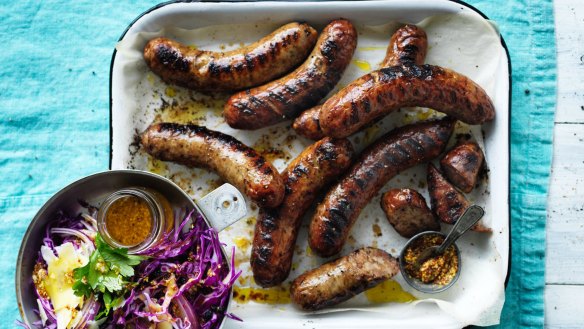
- The ultimate barbecue guide, featuring top meat cuts for the barbecue
- 40 of the best barbecue recipes from Adam Liaw
Why do sausages curl, and how can I brown them all over? S. Munday
Good sausages – and I mean sausages made by a proper butcher with a blue striped apron, big sideburns and a penchant for double entendre – are made with real animal intestines.
Cleaned and scrubbed to within an inch of their life, the sausage casings once coiled around the inside of a pig or sheep.
All that coiling can't be undone, and snags made with natural skins will always tend to have that crescent shape. Bangers made with processed collagen skins, like those handed out on the forecourt of large hardware stores, don't have that curve. Befriend your local butcher and ask for their advice.
For uniformly bronzed sausages, evenly space them on a tray, not touching, and roast them in the oven at 200C (180C fan-forced) for 20-25 minutes, turning once. You can use the pan juices to make a little gravy.
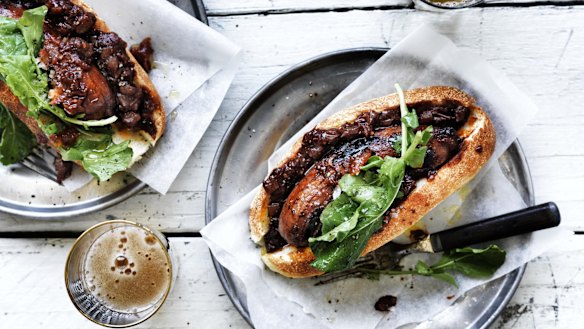
How do I stop sausages from splitting on the barbecue? My sausages always split. W. Johns
I remember my father making raging fires in the brick fireplace in the backyard. Impatient or just wanting to feed the hungry family, the sausages and chops would go on the red hot steel plate. The chops ended up burnt, and the sausages disgorged their innards onto the barbecue.
Sausages are encased in animal gut, or extruded collagen, that is very thin. Fierce heat will expand the innards of a snorker too quickly, causing the skin – rendered brittle by the heat – to fail.
A such, sausages require low, slow heat to cook the interior and allow the skin to brown and caramelise. Take your time.
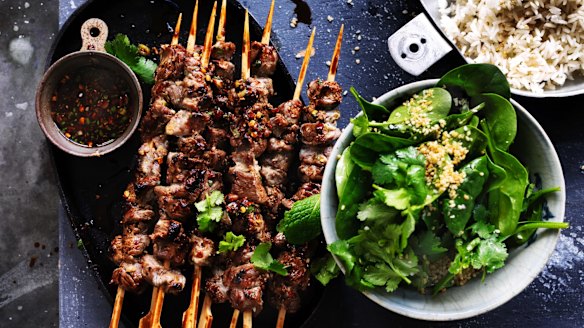
What's the secret to cooking the perfect sausage? P. Humphreys
A great mate of mine was brought up on a sheep station in western Victoria. It was one of those big old houses built at the end of the 19th century with wide verandahs with a well in the courtyard. They ate what they grew and grew what they ate.
"I never knew you could cook a sausage in a frying pan until I left home and moved to the city," she told me recently. "We cooked everything in the Aga," she told me, referring to the classic wood-fired stove made with about as much steel as a Panzer tank. The radiant heat cooks the sausages and crisps the skin and the steady, even heat means the sausages almost never split. If you have a well-made sausage you can also make gravy with the pan juices.
For golden oven-roasted snags, preheat the oven to 200C (180C fan-forced), place the sausages on a rack in a roasting tray and cook for 20 minutes until done. Sausages, like all meat, love a little rest before being served.
Sausages. To prick or not to prick? That is the question. L. Gamble
We once had an airline called Ansett. They used to serve sausages for breakfast. They were so full of fat that a big air bubble trapped inside would travel from one end of the sausage to the other as the plane banked, like a meaty spirit level. So full of fat but so bloody delicious.
It made flying with a hangover bearable. We get this "to prick or not to prick" question every summer as people's thoughts turn to barbecues. I always think of sausages as winter food.
They are so full of energy from the fat, up to 50 per cent fat by law. A good sausage is about 30 per cent fat. Italians make the best sausages, in my opinion, with decent chunks of meat and fat, well mixed, well seasoned and well spiced.
If you prick a sausage you lose not only the fat but the moisture and end up with a dry sausage. The fat ends up catching fire and you have a flare-up.
Cook sausages over low heat slowly. Never prick. If you don't want to eat the fat, have some salad instead.
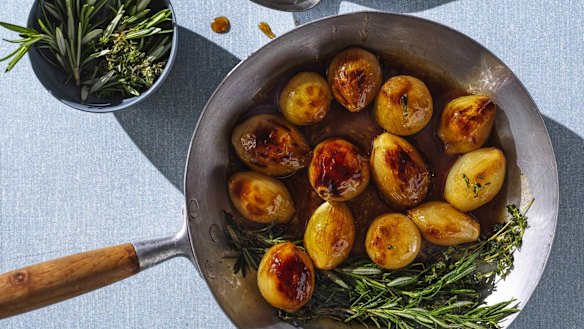
I was cooking onions for a sausage sizzle for my kids' school (I have never cooked onions on a barbecue before) and they ended up dry and burned. D. Kavanagh
I think I have eaten your onions. Many times. Which leads me to ask: "Why are the onions in the sausage on bread sold at sausage sizzles so burned, bitter and bereft of flavour?" If you are asked to do this important fundraising chore again make sure the barbecue is turned down low.
- Slice the onions finely. Season them with salt and massage the salt through the onions. This will soften the onions and draw out liquid.
- Take a great big double handful of the onions and place it on the hotplate with as much liquid as you can manage. Resist the temptation to stir the onions for five minutes or so.
- Then turn the onions and leave them in a great pile. If you spread them out they will become dry. By keeping them in a pile they will become soft and golden, the sugar-laden juice drawn out by the salt caramelising around the edges.
- When cooking the sausages, cook them low and slow as well. Make sure you scrape away excess hot fat as this can get to well above 200C, making the collagen casing fall away.
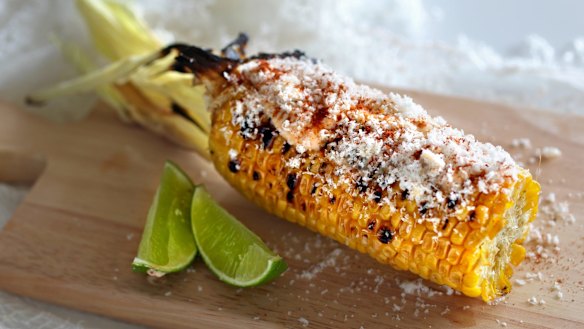
How do I stop my corn husks from burning on the barbecue? L. Fischer
Try soaking the cobs in cold water for 30 minutes before cooking, turning the heat down and turning the corn frequently. Unless the corn is freshly picked, there's a good chance the husks have dried out.
A good soak will rehydrate them and prevent the exterior from burning while creating steam to cook the kernels inside.
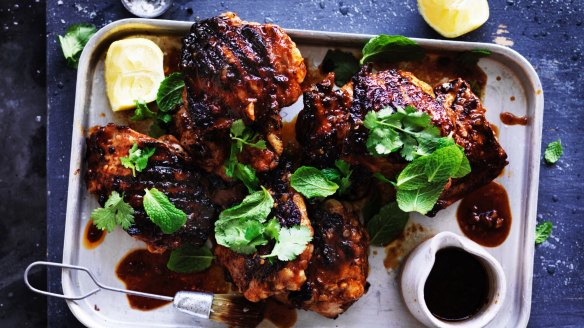
My sister-in-law told me off for cooking sausages and chicken side by side on the barbie, saying we would all get food poisoning. J. Handly
I am sure your sister-in-law was well meaning, as the Food Safety Information Council warned about the dangers of food poisoning and barbecues. In this hyper-vigilant world it is best to be alert but not alarmed when it comes to warm weather and keeping raw meat.
The big problem with mixing red and white meat is in the raw state, as chicken can contain salmonella that can breed in raw meat at warm temperatures.
Cooking chook and sausages until done will kill the bugs your sister-in-law was worried about.
The council issued a few tips on handling raw meat. It suggests keeping all meat under 5C either in the fridge or in a cooler packed with ice until you're ready to cook it.
Wash hands before and AFTER handling raw meat or chicken.
Don't guess the doneness of chook, snags or burgers. The interior should be 75C so, use a meat thermometer. Don't contaminate cooked meat by putting it back on the plate the raw meat was on.
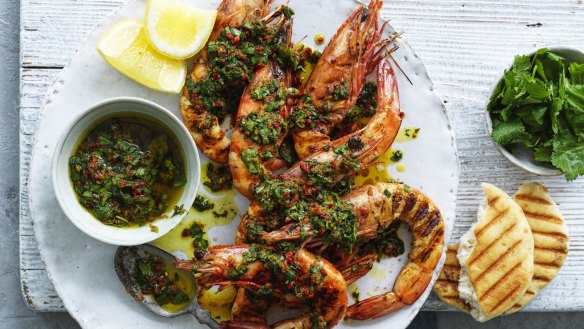
When I barbecue prawns, the flesh sticks to the shells. How do I fix this issue? T. Plunkett
It could be a case of overcooking. When you apply heat to a prawn in its shell, moisture in the flesh turns to steam and sets the protein. That steam also helps separate the meat from the shell.
Cook the prawns too long, though, and the moisture evaporates and the proteins start to meld to the shell, itself made of a tough but flexible protein called chitosan.
Prawns do not take long to cook on the barbie – about three minutes on each side on a hot grill. Remove onto a plate and cover to allow the flesh to rest.
I love the drama of salt prawns in which you take a bowl of raw prawns in their shells, cover them with a cup of salt, mix, set aside for 15 minutes, then put on the barbecue grill on very high, cook for a few minutes each side, rest and serve with ice-cold beer.
The salt does not penetrate the meat but does help give it a lovely smoky tang as the shell sears over the heat.
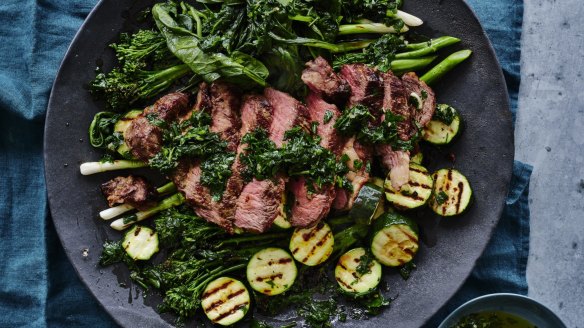
I'm grilling steak. When do I sprinkle it with salt? K. Hansen
Some say don't. We have enough salt in our diets. A little salt does enhance the flavour, however. If you sprinkle a steak with salt and leave it for a few minutes or more the salt will draw out moisture from the flesh through osmosis.
This creates a layer of basically water that will pull heat from the grill as it evaporates, dulling the sear capacity of the grill. Leave the salt on for around 45 minutes and that salty moisture will be absorbed back into the muscles. This gives you a deeply seasoned steak. Most chefs I know season their steak just before it hits the grill. If you have time, give this long seasoning time a try.
Should you wear gloves when handling raw meat?
Gloves are the politically correct barrier protection of the food world. They make a statement that you care about food safety but they are not an effective prophylactic because very often they are not used correctly.
To get one thing straight, the Australian Food Standards Code does not require food handlers to wear gloves. There is no government regulation that demands you wear gloves. They may lend staff in a sandwich bar the appearance that they understand food safety, but if staff handle raw meat with gloves then make your egg and lettuce sandwich, there is still a risk from cross-contamination.
Food handlers with bandages, sores, broken skin or false nails should wear gloves as these are avenues for passing on bugs.
Food handlers are required to have clean hands that have been washed in hot water with soap and dried with a single-use paper towel.
Hands need to be rewashed after using the toilet, smoking, sneezing, coughing, using a handkerchief, touching the scalp, hair or body. Sounds like common sense. Some food businesses prefer their workers to wear gloves and replace them after doing any of the activities mentioned above.
A food safety expert I spoke to said a pair of clean, healthy hands that were washed whenever there was a chance of cross-contamination were just as safe as gloved hands.
We've become accustomed to a culture of hygiene aesthetics where a food handler making your sausage in bread appears to be cleaner than a person making your roll with clean "nude" hands.
Just remember the old soap advertising slogan – "Wash your hands, Geoffrey".
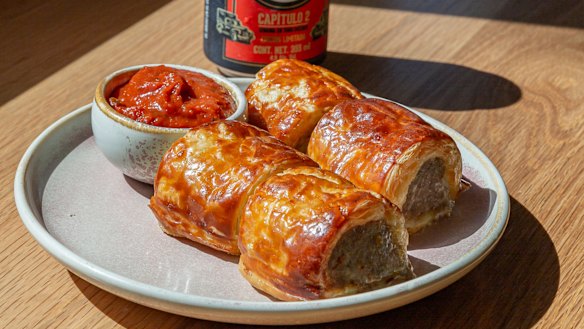
Can I use sausages in sausage rolls? I. Maloney
You can make sausage rolls using sausages but choose low-fat snorkers. Sausages are packed with fat. The average sausage contains about 20 per cent fat, and some up to 30 per cent. If wrapped in pastry, that fat renders out and drenches the bottom of the pastry. The fat then heats up and fries the pastry. The same thing happens if you use fatty pork mince.
- For better results, remove sausages from their skins and mix through some extra herbs and perhaps some breadcrumbs soaked in milk, then squeezed to reduce the liquid content. This will make the mixture slightly less dense.
- You could also add a few tablespoons of tomato sauce. Mix well. Do not add salt. Sausages are already well seasoned.
- You can wrap a sausage in puff pastry, brush with egg wash, pop it into the oven preheated to 180C and cook it for 20-25 minutes and you will have something resembling the fast food you walk past at an agricultural show.
We are making home-made sausages at the weekend. My mate wants us to make a low-salt sausage. Is this possible? H. Pearce
Repeat after me. Sausages. Are. Not. Health. Food. They are delicious meaty morsels that require both fat and salt for their very existence.
The Italian, Spanish and French words salsiccia, salchicha and saucisse respectively all come from the Latin salus meaning "salted".
A fresh sausage should be 2 per cent salt of the total weight of the meat. Salt draws the meat protein myosin into the brine formed between pieces of ground meat and fat, creating a gel.
Mixing and resting assists this. When cooked, the gel helps set the sausage like glue, sticking the pieces together. Without salt, a sausage would be a grainy bag of boiled mince.
I am making sausages at home. How do I stop fat from smearing on the sausage skins? F. Lawrence
This is quite an embarrassing problem. It's the home butchery equivalent of a flat sponge cake or runny marmalade. It happens when the fat you are using gets too warm. Some types of fat begin to become liquid at quite low temperatures. Imagine butter in a Cloncurry kitchen. Liquid. When you mix together lean meat and fat, as one does in sausage making, friction occurs. This warms the meat.
If the meat and fat are not cold enough the fat can begin to melt and this ends up coating the inside of the sausage skin, resulting in an unpleasant-looking smear on the inside of the translucent skin. Avoid this by keeping your meat chilled, even placing it in the freezer to chill for about 45 minutes before mincing and blending. Chill but don't freeze the meat and fat.
Remember to follow the three Cs when making sausages: Clean, cold and quick (Q is technically not a C but ''three Cs'' is a better alliterative mnemonic). Keep surfaces and hands scrupulously clean. Keep meat and fat cold – this might mean putting trays or bowls back in the fridge to keep the temperature down. Be quick. Don't dawdle. Don't let the sausage ingredients lie around getting warm.
My sausage meat always clogs the sausage mincer. J. Gerard
The weather has turned and, quite naturally, any good cook's thoughts are turning to sausages. The rise of home-made sausages and house-made snags in restaurants in the past few years has greatly increased the quality of snorkers, as the Brits call their bangers.
This also means a move away from the classic ''mystery bag'', the derisive term for the fact that if you put enough seasoning on low-grade meat, mince it, and stuff it into sausage casing you can get away with anything.
On that, if you're buying flavoured sausages from butchers avoid the stuff made with pre-mixed flavourings - the number of E numbers in that stuff is remarkable.
As to your problem, the protein myosin in sausage meat coagulates at 50C. You need to rinse the meat off the equipment in cold water before you wash it in hot water, otherwise the meat will ''cook'' and hold fast.
From our partners
Original URL: https://www.watoday.com.au/goodfood/brain-food-bestof-all-your-sausage-and-barbecue-questions-answered-20230126-h29elo.html